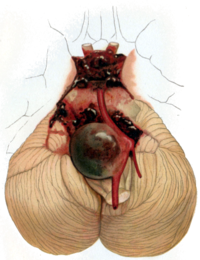
Photo from wikipedia
OBJECTIVE Many new endovascular devices have been used under the guidance of the International Subarachnoid Aneurysm Trial. Clipping still offers higher occlusion rates, and its technique continues to evolve, resulting… Click to show full abstract
OBJECTIVE Many new endovascular devices have been used under the guidance of the International Subarachnoid Aneurysm Trial. Clipping still offers higher occlusion rates, and its technique continues to evolve, resulting in smaller exposures and reduced manipulation to brain tissue. We sought to evaluate the routine use of the minisphenoidal approach to manage intracranial aneurysms in a high-volume institution. METHODS We retrospectively reviewed our database of patients with aneurysm from October 2013 to May 2016. Data were originally collected prospectively. The minisphenoidal approach has been progressively replacing the pterional approach for managing aneurysms in our department. Occlusion rates for ruptured and unruptured aneurysms were analyzed using late follow-up angiograms. Functional outcome assessment and the impact on quality of life were also measured. RESULTS We performed 124 minisphenoidal craniotomies in 117 patients to clip 147 aneurysms. Patient mean age was 53.9 years. Seventy patients (59.8%) presented with subarachnoid hemorrhage. Middle cerebral artery aneurysms represented 48% of the total number of aneurysms; posterior communicating artery aneurysms represented 24%. The minisphenoidal craniotomy was helpful in managing superior cerebellar artery aneurysms and 1 ruptured orbitofrontal artery aneurysm. We achieved an occlusion rate of 97.8%, with a mean follow-up of 13.2 months. Favorable outcomes were achieved for 79% of patients with subarachnoid hemorrhage and for 98% of unruptured patients. CONCLUSIONS Evolution of endovascular techniques has paved the way for minimizing surgical exposures. Routine use of the minisphenoidal approach for managing ruptured, unruptured, and previously coiled aneurysms is safe and provides adequate exposure with robust occlusion rates.
Journal Title: World neurosurgery
Year Published: 2017
Link to full text (if available)
Share on Social Media: Sign Up to like & get
recommendations!